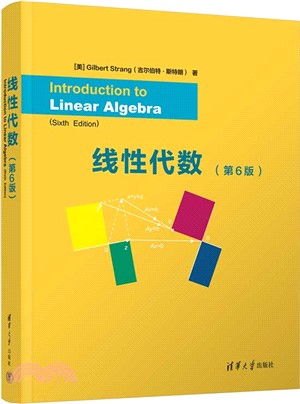線性代數(第6版)(簡體書)
商品資訊
ISBN13:9787302668077
替代書名:Introduction to Linear Algebra, Sixth Edition
出版社:清華大學出版社(大陸)
作者:(美)吉爾伯特‧斯特朗
出版日:2024/08/01
裝訂/頁數:平裝/430頁
規格:24cm*17cm (高/寬)
版次:六版
商品簡介
線性代數內容包括行列式、矩陣、線性方程組與向量、矩陣的特征值與特征向量、二次型及Mathematica 軟件的應用等。 每章都配有習題,書后給出了習題答案。本書在編寫中力求重點突出、由淺入深、 通俗易懂,努力體現教學的適用性。本書可作為高等院校工科專業的學生的教材,也可作為其他非數學類本科專業學生的教材或教學參考書。第一章:向量簡介。圍繞向量和點積的概念,在平面和空間中引入了線性組合和線性無關的概念。
第二章:求解線性方程組。從這個基本點出發,自然引入矩陣,高斯消元,初等矩陣,可逆矩陣等重要概念,并講述了LU分解。
第三章:線性空間與子空間。從幾何的角度來理解線性方程組,引入矩陣的秩,空間的維數等重要概念。導出線性代數基本定理。
第四章:正交。給出四個基本子空間的正交關系,引入最小二乘法,以及Gram-Schmidt正交化。
第五章:行列式。從體積的角度引入行列式,證明其各種基本性質
第六章:特征值與特征向量。從如何計算方陣的高次冪出發,給出引入二者的動機。然后講解矩陣的對角化,對稱矩陣,正定矩陣。
第七章:奇異值分解。介紹了奇異值分解這個基本定理,并給出了很多應用,例如求解常微分方程,圖像壓縮等。
第八章:線性變換。引入抽象的線性變換的概念,講述線性變換的矩陣表示,對角化與偽逆。
第九章:復向量與復矩陣。討論如何自然的引入和考慮復矩陣。然后講解Hermitian矩陣和酉矩陣,并重點介紹了快速Fourier變換這一工程上極端有用的理論,
第十章:應用。這一章集中講授了線性代數在各個領域中的應用。
第十一章:數值線性代數。從計算實現的角度來重新看線性代數。這一部分是算法,科學計算等的一個入門介紹。
第十二章:概率與統計中的線性代數。從線性代數的理論角度審視概率統計中的基本概念,尤其是多元隨機變量,多元正態分布以及加權最小二乘法。
作者簡介
William Gilbert Strang(威廉·吉爾伯特·斯特朗),1934年11月27日于芝加哥出生,是美國享有盛譽的數學家,在有限元理論、變分法、小波分析及線性代數方面均有所建樹。他對教育的貢獻尤為卓著,包括所著有的七部經典數學教材及一部專著。斯特朗自1962年擔任麻省理工學院教授,其所授課程《線性代數導論》、《計算科學與工程》均在麻省理工學院開放式課程計劃(MIT Open Course Ware)中收錄,并獲得廣泛好評。
名人/編輯推薦
Gilbert Strang的《線性代數(第5版)》是一本經典線性代數教材。此書深入淺出地展示了線性代數的所有核心概念,講述過程中恰當穿插了各種應用,體現了線性代數極端有用的思想。
序
One goal of this Preface can be achieved right away. You need to know about the video lectures for MIT’s Linear Algebra course Math 18.06. Those videos go with this book, and they are part of MIT’s OpenCourseWare. The direct links to linear algebra are
https://ocw.mit.edu/courses/18-06-linear-algebra-spring-2010/ https://ocw.mit.edu/courses/18-06sc-linear-algebra-fall-2011/
On YouTube those lectures are at https://ocw.mit.edu/1806videos and /1806scvideos
The .rst link brings the original lectures from the dawn of OpenCourseWare. Problem solutions by graduate students (really good) and also a short introduction to linear algebra were added to the new 2011 lectures. And the course today has a new start—the crucial ideas of linear independence and the column space of a matrix have moved near the front.
I would like to tell you about those ideas in this Preface.
Start with two column vectors a1 and a2. They can have three components each, so they correspond to points in 3-dimensional space. The picture needs a center point which locates the zero vector :
. . . . . .
2 1 0
a1 = . 3 . a2 = . 4 . zero vector = . 0 . .
1 2 0
The vectors are drawn on this 2-dimensional page. But we all have practice in visualizing three-dimensional pictures. Here are a1, a2, 2a1, and the vector sum a1 a2.
..
3
.. ..
a1 a2 =71 3
24
0
.. ..
a1 =3 2a1 =6
12
i
That picture illustrated two basic operations—adding vectors a1 a2 and multiplying a vector by 2. Combining those operations produced a “linear combination” 2a1 a2 :
Linear combination =ca1 da2 for any numbers c and d
Those numbers cand dcan be negative. In that case ca1 and da2 will reverse their direc-tions : they go right to left. Also very important, c and d can involve fractions. Here is a picture with a lot more linear combinations. Eventually we want all vectors ca1 da2.
目次
1 Vectors and Matrices 1
1.1 Vectors and Linear Combinations 2
1.2 Lengths and Angles from Dot Products 9
1.3 Matrices and Their Column Spaces 18
1.4 Matrix Multiplication AB and CR 27
2 Solving Linear Equations Ax = b 39
2.1 Elimination and Back Substitution 40
2.2 Elimination Matrices and Inverse Matrices 49
2.3 Matrix Computations and A = LU 57
2.4 Permutations and Transposes 64
2.5 Derivatives and Finite Difference Matrices 74
3 The Four Fundamental Subspaces 84
3.1 Vector Spaces and Subspaces 85
3.2 Computing the Nullspace by Elimination: A = CR 93
3.3 The Complete Solution to Ax = b 104
3.4 Independence, Basis, and Dimension 115
3.5 Dimensions of the Four Subspaces 129
4 Orthogonality 143
4.1 Orthogonality of Vectors and Subspaces 144
4.2 Projections onto Lines and Subspaces 151
4.3 Least Squares Approximations 163
4.4 Orthonormal Bases and Gram-Schmidt 176
4.5 The Pseudoinverse of a Matrix 190
5 Determinants 198
5.1 3 by 3 Determinants and Cofactors 199
5.2 Computing and Using Determinants 205
5.3 Areas and Volumes by Determinants 211
6 Eigenvalues and Eigenvectors 216
6.1 Introduction to Eigenvalues : Ax = λx 217
6.2 Diagonalizing a Matrix 232
6.3 Symmetric Positive De?nite Matrices 246
6.4 Complex Numbers and Vectors and Matrices 262
6.5 Solving Linear Differential Equations 270
vii
viii Table of Contents
7 The Singular Value Decomposition (SVD) 286
7.1 Singular Values and Singular Vectors 287
7.2 Image Processing by Linear Algebra 297
7.3 Principal Component Analysis (PCA by the SVD) 302
8 Linear Transformations 308
8.1 The Idea of a Linear Transformation 309
8.2 The Matrix of a Linear Transformation 318
8.3 The Search for a Good Basis 327
9 Linear Algebra in Optimization 335
9.1 Minimizing a Multivariable Function 336
9.2 Backpropagation and Stochastic Gradient Descent 346
9.3 Constraints, Lagrange Multipliers, Minimum Norms 355
9.4 Linear Programming, Game Theory, and Duality 364
10 Learning from Data 370
10.1 Piecewise Linear Learning Functions 372
10.2 Creating and Experimenting 381
10.3 Mean, Variance, and Covariance 386
Appendix 1 The Ranks of AB and A B 400
Appendix 2 Matrix Factorizations 401
Appendix 3 Counting Parameters in the Basic Factorizations 403
Appendix 4 Codes and Algorithms for Numerical Linear Algebra 404
Appendix 5 The Jordan Form of a Square Matrix 405
Appendix 6 Tensors 406
Appendix 7 The Condition Number of a Matrix Problem 407
Appendix 8 Markov Matrices and Perron-Frobenius 408
Appendix 9 Elimination and Factorization 410
Appendix 10 Computer Graphics 414
Index of Equations 419
Index of Notations 422
Index 423
主題書展
更多書展今日66折
您曾經瀏覽過的商品
購物須知
大陸出版品因裝訂品質及貨運條件與台灣出版品落差甚大,除封面破損、內頁脫落等較嚴重的狀態,其餘商品將正常出貨。
特別提醒:部分書籍附贈之內容(如音頻mp3或影片dvd等)已無實體光碟提供,需以QR CODE 連結至當地網站註冊“並通過驗證程序”,方可下載使用。
無現貨庫存之簡體書,將向海外調貨:
海外有庫存之書籍,等候約45個工作天;
海外無庫存之書籍,平均作業時間約60個工作天,然不保證確定可調到貨,尚請見諒。
為了保護您的權益,「三民網路書店」提供會員七日商品鑑賞期(收到商品為起始日)。
若要辦理退貨,請在商品鑑賞期內寄回,且商品必須是全新狀態與完整包裝(商品、附件、發票、隨貨贈品等)否則恕不接受退貨。
























